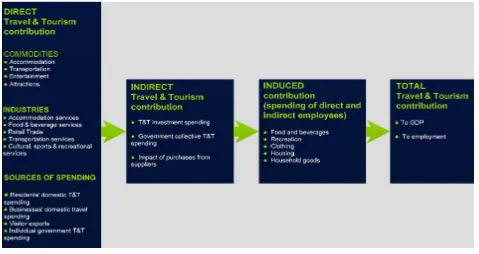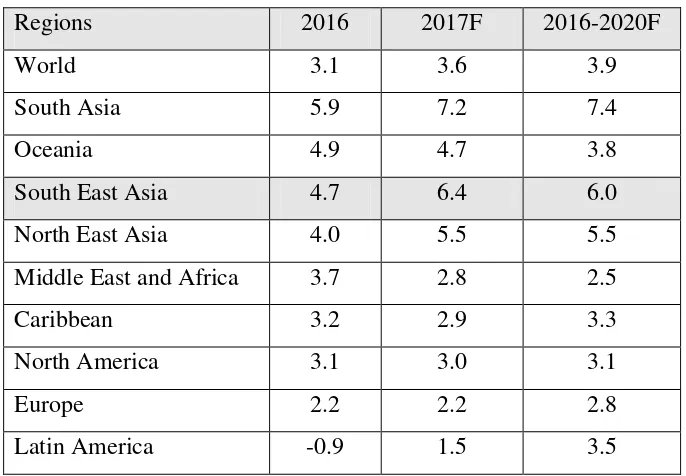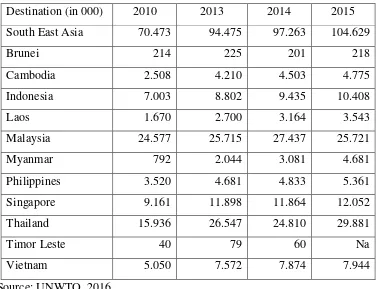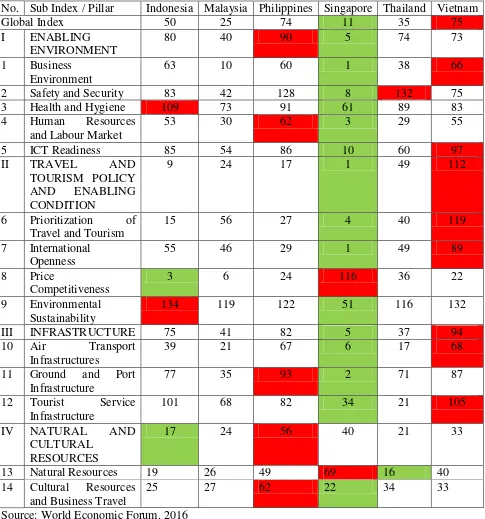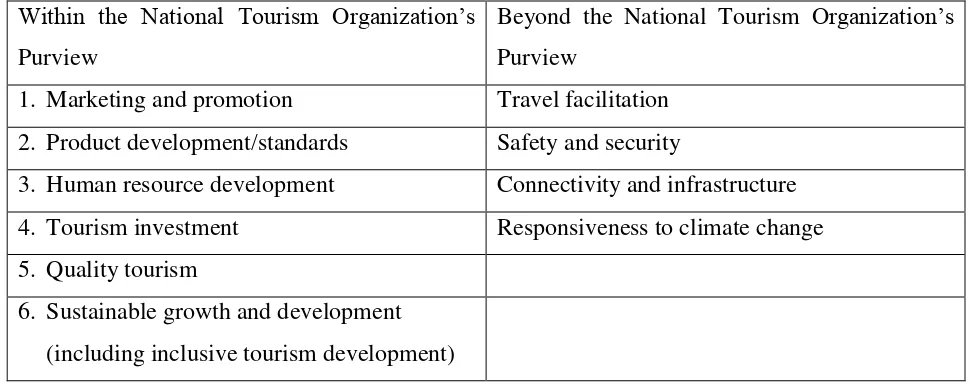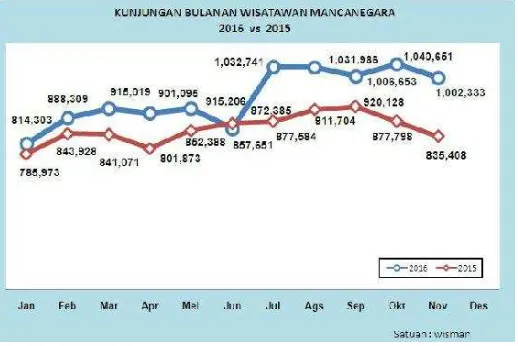THE CULTURAL TOURISM: AN INDONESIAN PERSPECTIVE
Werner R. Murhadi Universitas Surabaya, Indonesia
Abstract
Nowadays, Travel and Tourism is an important economic activity in most countries around the world. As well as its direct economic impact, the sector has significant indirect and induced impact. This paper has objective to inform impact of Tourism Sector to the National Economic growth, describe ASEAN tourism conditions, and Indonesia practices for Tourism sector. There are many opportunities and challenges in the field of tourism. ASEAN countries have the same problem with Indonesia. The main weaknesses are in the areas of infrastructure and business environment, regulatory framework and human resources. Furthermore, this paper will explain Indonesia's tourism strategy.
Keywords: Travel, Tourism, Economic Growth
A. Introduction
Year 2016 has been passed with growth slowing to around 2.3%, while this will be the slowest growth rate since 2009. Economic growth is expected to increase in 2017 to 3%. The fastest growing growth region in 2016, 2017, 2016-2020 will be South Asia, led by strong growth in India, whose economy is expected to outperform China. Against this backdrop, commodity prices remain relatively subdued, with the price of oil edging up to only around USD 70/barrel. Over the longer term to 2020, world GDP growth is forecast to average 2.6% (WTTC, 2016). Brexit and US new president policies will influence economic growth in the coming years. In an increasingly connected world, the economy of a country will affect the economies of other countries.
as a basis for development of the international community. Paradox presented by John Naisbit in his book is that the unexpected will appear in the surface and into something real. The dramatic changes and very different in the world in the late twentieth century can almost be understood as follows: the global economy, global communications, the countries is fragmented, its own self-determination of the ethnic-specific, emerging economies, and increased tourism. Following the development of a paradox, Naisbitt said it would be a revolution in telecommunications. Exchange of information almost instantaneously around the globe makes individuals, small businesses, and countries that are just beginning to have a great opportunity to become the new ruler of the world. Naisbitt also details the emerging synthesis of computer, telephone, and television, as well as identifying the power of technology and the companies that make up the development of information, which he called the superhighway Travel and tourism industry also plays an important role in the global paradox, says Naisbitt, by providing funding for the global economy. He said that the current human will be more integrated with the world, the more they have different cultures and experiences, the more it tends to take a trip to visit the place of different cultures. In the chapter on the new rules of behavior, Naisbitt said that a new awareness of other cultures and their greater visibility for telecommunications will generate greater empathy with and concern for the suffering of others. Naisbitt explained that tourism is a contributor to the global economy that is unmatched in the future.
Figure 1. Impact o f Travel and Tourism Sector to GDP Growth (Sources: WTTC, 2016a)
up to US$ 1.5 trillion, or US$ 4 billion a day on average. International tourism now represents 7% of the world‟s exports in goods and services, up from 6% in 2014, as tourism has grown faster than world trade over the past four years. (UNWTO, 2016).
Southeast Asia Travel& Tourism Conditions
The global competitiveness reports and surveys reveal that ASEAN‟s natural and cultural heritage is one of its key competitive strengths. Southeast Asia has rich and diverse set of natural and tangible and intangible cultural tourism Resources located in both rural and urban areas. The region‟s 11 natural and 17 cultural heritage sites inscribed in the UNESCO World Heritage List highlight and reflect its unique heritage. Enmeshed with its natural heritage is a rich and diverse endemic ethnic culture with overlays of Arab, Chinese, Indian, and European influences. Buddhist, Hindu, Muslim and Christian religious traditions, and vernacular architecture, music, literature, and indigenous knowledge enrich the region and add to the appeal of its outstanding natural heritage, its rural landscapes, and its vibrant urban centers.
Southeast Asia is one of the areas experiencing high growth in tourism. It can be seen from Table 1.
Table 1. Travel and Tourism Growth
Regions 2016 2017F 2016-2020F
World 3.1 3.6 3.9
South Asia 5.9 7.2 7.4
Oceania 4.9 4.7 3.8
South East Asia 4.7 6.4 6.0
North East Asia 4.0 5.5 5.5
Middle East and Africa 3.7 2.8 2.5
Caribbean 3.2 2.9 3.3
North America 3.1 3.0 3.1
Europe 2.2 2.2 2.8
Latin America -0.9 1.5 3.5
Developments of tourism in Southeast Asia are very different from one country to another country. With the enactment of AEC (ASEAN Economic Community) is expected to encourage the growth of the tourism sector in ASEAN increasing. It can be seen from Table 2. The trend of tourist visits to ASEAN countries increased. The increase in tourist arrivals will increase the contribution of tourism sector to the GDP.
Table 2. International Tourist Arrival to ASEAN Countries
Destination (in 000) 2010 2013 2014 2015
South East Asia 70.473 94.475 97.263 104.629
Brunei 214 225 201 218
Cambodia 2.508 4.210 4.503 4.775
Indonesia 7.003 8.802 9.435 10.408
Laos 1.670 2.700 3.164 3.543
Malaysia 24.577 25.715 27.437 25.721
Myanmar 792 2.044 3.081 4.681
Philippines 3.520 4.681 4.833 5.361
Singapore 9.161 11.898 11.864 12.052
Thailand 15.936 26.547 24.810 29.881
Timor Leste 40 79 60 Na
Vietnam 5.050 7.572 7.874 7.944
Source; UNWTO, 2016
Figure2. Direct Contribution of Travel and Tourism to GDP Source: WTTC (2016b)
Under the ASEAN Economic Community pillar, tourism is one of the priority sectors for integration by 2015. Tourism represents an important component of the economy of all ASEAN Member States—especially in Cambodia, Lao PDR, Malaysia, Philippines, and Thailand, where Tourism accounts for more than 10% of GDP and contributes significant employment in their economies. According to the WTTC, in 2015 the ASEAN Member States generated US$115.5 billion in tourism exports or foreign exchange earnings and total contribution reaching $301.7 billion in value added linked to the travel and tour operations, shopping, entertainment, transportation, and various other tourism-related service occupations and productive sectors, accounting for 12.40% of regional GDP.
Table 3. Travel and Tourism Competitiveness Index 2015: Six Asean Countries
No. Sub Index / Pillar Indonesia Malaysia Philippines Singapore Thailand Vietnam
To increase the attractiveness of ASEAN tourism, then developed the vision of ASEAN as a single tourist destination that is “By 2025, ASEAN will be a quality tourism destination offering a unique, diverse ASEAN experience, and will be committed to responsible, sustainable, inclusive and balanced tourism development, so as to contribute significantly to the socioeconomic well-being of ASEAN people.” To achieve this vision, the focus of ASEAN to develop 10 tourism development areas included in the ASEAN Tourism Strategic Plan (ATSP). Ten focus areas can be seen in Table 4.
Table 4. Ten Focus Area of The ASEAN Tourism Strategic Plan Within the National Tourism Organization‟s
Purview
Beyond the National Tourism Organization‟s Purview
1. Marketing and promotion Travel facilitation 2. Product development/standards Safety and security
3. Human resource development Connectivity and infrastructure 4. Tourism investment Responsiveness to climate change 5. Quality tourism
6. Sustainable growth and development (including inclusive tourism development) Source: The ASEAN Secretariat, 2015
Some of the focus areas are briefly described below:
Marketing and promotion is done by creating a branding ASEAN is "South East Asia: Feel the Warmth". It is expected with this branding, will encourage tourists from around the world will want to visit the countries in ASEAN.
product and completed the Project titled “ASEAN Culture and Heritage Tourism Product Development in ASEAN Member States” that sets out a strategy and work plan for developing cultural heritage packages, developing cultural & heritage travel packages, conducting a familiarization trip based on the “Trail of Civilization” circuit/corridor, organizing a Old town / Colonial home-stay fair, and ASEAN Traditional Cuisine Coffee Table Book. With Cambodia as Lead Coordinator, completed work plan and detailed activities for the Development of ASEAN community-based tourism product and identification of community-based tourism products. With Singapore as the Lead Coordinator of cruise tourism, completed an International Cruise Workshop and a Special Meeting of ASEAN Cruise Tourism. With Thailand as Lead Coordinator, completed the ASEAN Health and Wellness Tourism product template is being developed with close consultation with the Spa Association and its Ministry of Public Health. Human resource, to improve the qualifications of HR then developed a set of ASEAN tourism standards with a certification process, and Implement the ASEAN Mutual Recognition Arrangement on Tourism Professionals and its Requirements.
Further below are presented several programs ASEAN Countries (Trinity, 2016) Thailand
The number of foreign tourists coming to Thailand is the highest compared to all ASEAN countries, as many as 29.8 million people during 2015. Tourism accounts for the largest state revenue by $ 42 billion in 2015 and expects to USD 66 billion in 2016. Thailand use brand identification as "Amazing Thailand". Amazing Thailand also launched tourism logo with a new tagline "Where life rules everything". Thailand tourism focus in 2016 is a luxury tourist, inter alia by improving cruise ship tourism in the area (less than 10,000 foreign tourists / year), golf, medical tourism, health & wellness. Thailand also develops community based tourism in remote areas and female travelers.
Malaysia
world. Tourism program among others is to hold festivals and culinary arts, ranging from mask art, street food, halal food, as well as durian festival. Malaysia already has 17 theme parks including the soon to be opened, namely DreamWorks, Nickelodeon, and 20th Century Fox! Another interesting program is the "Malaysia My Second Home" where retirees from any foreign country can live in Malaysia with the requirement to have assets of at least 350,000 ringgit. Malaysia has brand identification as "Truly Asia".
Singapore
Foreign tourists come to Singapore about 15 million people, which brings income to Singapore around SGD 24 billion. Most incoming foreign tourists mostly came from Indonesia with 2.4 million people / year (while the Singaporean tourists entering Indonesia 1.5 million people / year). Singapore tourism promotion program created target market segmented by country, for example for the Philippine market their music video featuring famous Filipino band that filming in Singapore, and for the Chinese market they create digital apps in the local language. Singapore also make contemporary art exhibition in Beijing, London, New York to introduce his country. Singapore tourism board collaborated with Trip Advisor to make a special micro site "Live like a local". Singapore also made a culinary event / music / international sports such as Master Chef Asia and Asia's Got Talent. Singapore uses brand identification as "Your Singapore".
Indonesia
The number of foreign tourists who entered Indonesia in 2015 was 10 million, and in 2019 the target is 20 million people, with a top 3 market came from Singapore, Malaysia and Australia. Indonesian tourism program is the exemption of visas for 90 countries in the world, increasing the promotion budget by 300%, and developing 10 priority destinations. Indonesia use brand identification as "Wonderful Indonesia".
Vietnam
The number of foreign tourists coming to Vietnam comes from China, South Korea and Japan. Visit Vietnam Vietnam launched in 2016 with a focus on remarkable destinations in Phu Quoc Island - Mekong Delta, the city of Danang, Hanoi and Ho Chi Minh City. Vietnam use brand identification as "Vietnam Timeless Charm"
Filipina
Foreign tourist arrivals to the Philippines reached 5 million / year, mostly from South Korea, the United States and Japan. Korean people are coming because they want to learn English less. Their program is a lot more to improve itself, among other things create a new accreditation system for accommodation, and improve accessibility by air and sea, tourism training, as well as developing a market niche that is scuba diving and medical tourism. Philippines use brand identification as "It's more fun in the Philippines".
Brunei, Cambodia, Myanmar, Lao
The number of foreign tourists coming into Lao PDR, Cambodia and Myanmar respectively reached an average of 3-4 millions / year. The interesting fact, the number of South Korean tourists increased 91% to Laos as there are Korean artists filming there. Cambodia uses brand identification as the "Kingdom of Wonder". Lao PDR use brand identification as "Simple Beautiful". Myanmar is brand identification as "Let the Journey Begin". Brunei reliable tourist destination is the village water. One of the proposed programs is Ramadan Festive where everyone can go to the palace to shake hands with the Sultan! Brunei has brand identification as "A Kingdom of Unexpected Treasures".
Cultural Tourism in Indonesia
Cultural tourism as one of the tourism product is a type of tourism that is due to the appeal of the arts and culture of a region. Cultural tourism is essentially a type of tourism that offers a culture both tangible and intangible, which are also living culture (a culture that still persists) and cultural heritage (cultural heritage of the past), as the main attraction to attract tourists. In the living culture, elements that can be used as an attraction among other traditions of a particular ethnic group, religious ceremonies and rituals, performing arts, and so on. While the cultural heritage, the attraction offered are relics of historical and archaeological, cultural landscape, and so on.
In the current era of globalization, there is a tendency that people want to understand the culture outside environment. According to Spillane (1989) that cultural tourism product has a special market segment, namely the "knowledge workers" or in terms of tourism called "mature tourist" where they travel or visits to other areas with the aim of not only recreational but are more motivated to gaining experience through direct engagement with life events and traditions and local culture. The traveler segment consists of the elderly or pensioners (retired) which generally is a group of upper middle and educated who have the free time to travel.
Figure 3. Data Foreign Tourists visit (Source: Ministry of Tourism)
In its report the World Bank is also using a reference from the World Travel and Tourism Council, that every $ 1 million spent on travel and tourism sector can support 200 jobs and bring $ 1.7 million to Indonesia's GDP. Tourism sector contributes 10 per cent of national GDP. National tourism GDP grew 4.8 percent with the trend rising to 6.9 per cent, much higher than the agriculture industry, automotive manufacturing and mining. Spend USD 1 million in the tourism sector also generate GDP of USD 1.7 million or 170 per cent, the highest compared to other industries. Currently, tourism is still ranked 4th as a contributor to national income, by 9.3 percent compared to other industries. Tourism accounted for 9.8 million jobs or 8.4 percent nationally and ranks fourth on the all industry sectors. In job creation, the tourism sector grew by 30 percent within five years. Tourism lowest job creation is by USD 5,000 / one employment, compared to the average of other industries USD 100,000 / one job.
Indonesia realizes the importance of the tourism sector to the economic growth in Indonesia. For that Indonesia develop tourism development goals as follows:
1. Growth Target
Description Baseline 2014 2019
Macro Indicator
Contribution to National GDP 9% 15 %
Employment (Millions) 11 13 Micro Indicator
Tourism Competitiveness Index #70 #30
Foreign Tourists (People) (Millions) 9 20
Nusantara/Local Travelers (Visits) (Millions) 250 275
2. Inclusive Development Goals
Improving local businesses in the tourism industry and increase the number of certified local workforce.
To achieve "growth targets" and "inclusive development" at the top, so the Indonesian government to make policy and tourism management strategies in the form of one of them:
Tourism Marketing
The type of tourism that is reliable in the promotion of foreign tourists to include:
I. Nature tourism is composed of marine tourism, ecological tourism and adventure tourism.
II. Cultural tourism, which consists of travel and religious heritage, culinary and shopping,
and tourist towns and villages.
III. Travel "creation" consisting of MICE travel & events, sports tourism, and tourism integrated area.
Indonesia is a country which has a wealth of natural and cultural resources that can be a great asset for the tourism sector. Tourism itself is one sector is the driving force in the economic growth of the country. With the potential of natural and cultural attractions are so large, the Indonesian tourism became one foreign exchange earner for the economy of Indonesia.
ASEAN countries have the same problem with Indonesia. The main weaknesses are in the areas of infrastructure and business environment, regulatory framework and human resources. Developing quality tourism destinations and products remains a major challenge for ASEAN.
Thus, the focus areas to raise competitiveness are marketing, product development, investments, quality tourism, human resources, connectivity and infrastructure and travel facilitation.
To harness the potential of tourism, the Indonesian government makes improvements both in terms of external and internal.
On the external side, to support this, the 169 State exempted from the obligation to have a visa for the purpose of the visit to Indonesia. This is stated in Presidential Decree No. 21 of 2016 signed by President Joko Widodo. Presidential Decree No. 21 of 2016 mandates that the Receiver Free Visit Visa granted a residence permit visits for 30 days and the period of validity cannot be extended or converted into any other residence permit. Free Visa Visits receiver can exit and enter through 124 Immigration Check Point. Foreign tourist‟s receiver Free Visit Visa can perform activities for the purpose of travel, family visits, social, arts and culture, administration tasks, giving lectures or seminars, followed the international exhibition, following a meeting held with headquarters or branches in Indonesia, and to continue trips abroad.
advances in information technology in the form of documentary film making, attractions introduction through the website, and the making of television programs.
In terms of internal, Indonesia is undertaking massive investments in infrastructure such as roads, airports, and seaports to facilitate access to various areas in order to increase the potential of cultural tourism.
Tourism development with accommodation facilities and access to tourism needs to be increased again. an example in Indonesia, one of the interesting attractions is the Raja Ampat (interesting sites of cultural and natural conditions), but to reach Raja Ampat requires an increase of more flights, especially low cost carriers (currently there is three flight from Jakarta, Makassar and Menado) to the city of Sorong. From Sorong then proceed with using the ferry to Raja Ampat. Around the Raja Ampat islands are still not many resort / hotel with international standards, and ships to round the island-island around Raja Ampat need to improve both the physical facilities and services.
The government also simplifies the permitting process to investors who want to open their business in Indonesia. For two years Jokowi government issued 13 policy packages. The target of this deregulation is to simplify and speed up the licensing process for infrastructure, small and medium enterprises, creative industries and tourism sector.
The Government also intensively develops new tourist destinations. There are several new tourist destinations are a priority that has been launched by the government since the beginning of 2016, namely Lake Toba with Traditional Batak Culture (North Sumatra), Tanjung Kelayang (Bangka Belitung), Tanjung Lesung (Banten), Kepulauan Seribu (Jakarta), Borobudur Temple ( Central Java), Bromo-Semeru Mountain with Traditional society namely Tengger (East Java), Mandalika and sasak culture (Nusa Tenggara Barat), Labuan Bajo with Bajo Community and “komodo” (East Nusa Tenggara), Wakatobi (Sulawesi southeast), Baduy people's lives (West Java) and travel Morotai (Maluku Utara).
facilitate community interaction with tourists who come. The government also encourages people to have a spirit of service that is friendly to the tourists. The government also asked businesses not to exploit tourists by increasing the selling price of goods / services. This gives a bad image when the tourists back to the country, or to give negative reviews on the site-famous tourist sites such as trip advisor. Improvements in the field of human resources, is expected to give a positive signal for foreign tourists and become word of mouth. Indonesia's current action is intended to Provide tourists with a high quality experience contributes to a heightened appreciation of our natural and cultural heritage. Offer tourism products and services that are consistent with community values and the surrounding environment. Foster greater public awareness of the economic, social, cultural, and environmental significance of tourism.
To continue to boost the performance of the tourism sector in 2017, then in 2017 the Ministry of Tourism and Indonesia launched three programs, namely "Go digital, air connectivity, and home stay tourism village". Target 2017, Indonesia visited by 15 million tourists. Of course this is a challenge when the growth rate was 4.4 percent traveler movement at the global level and 5.1 percent in the ASEAN region. In 2017, the Government set a target contribution of the tourism sector to the gross domestic product (GDP) reached 13 percent. In 2017, is also expected to enter the foreign exchange value of Rp 200 trillion, with 12 million workers absorbed, from the target of 15 million tourist arrivals and domestic tourists 265 movement.
Go Digital Tourism Movement, has already begun with the launch of the platform Indonesia Tourism Exchange (ITX) in September 2016. Go Digital Tourism is a digital platform market place in the ecosystem of tourism that brings buyers and sellers in cyberspace. In addition, it has also launched War Room M-17 at the Sapta Pesona building (center of tourism ministry), a monitoring center based on digital technology. In space installed 16 display monitor to monitor data trends and tourism marketing, and a variety of public input through a variety of digital media.
will be extended to 24 hours. Deregulation also is encouraged, especially for the ease of adding slot air coming into Indonesia.
After sales facilities and improved access, amenities were an absolute need to be ready. For that, the hotel rooms, resorts, and villas should also be possible. The fastest solution is to build a tourist village home stay in utilizing sharing with the local community.
Conclusion
The tourism sector is currently the backbone to the economy countries when manufacturing industry and others decreasing. The contribution of the tourism sector to the GDP growth rate in various countries has a tendency to increase. ASEAN and Indonesia have similar challenges in developing the tourism sector. The main weaknesses are in the areas of infrastructure and business environment, regulatory framework and human resources. Improvements in infrastructure can help mobilize the movement of people would support the tourism sector. The rules that hamper the tourism sector and its supporters, is expected to further reduced. Last, skills upgrading human resources is also a matter that must be considered.
Reference
Auliani, Palupi Annisa. 2017. Tiga Jurusa Indonesia Gaet Turis 2017. Harian Kompas. Terbitan tanggal 16/01/2017. Jakarta.
ASEAN. 2015. ASEAN Tourism Strategic Plan 2016-2025. The Association of Southeast Asian Nations
Spillane, James J. 1989. Ekonomi Pariwisata: Sejarah dan Prospeknya. Penerbit Gunung Mulya.
Naisbitt, John. 1994. Global paradox. William Morrow & Co.
S p i l a n e , J J . , 1 9 8 7 ,Pariwisata Indonesia, Sejarah dan Prospeknya, Kanisius, Yogyakarta
Trinity. 2016. Available at http://naked-traveler.com/2016/02/10/mengintip-program-pariwisata-negara-tetangga/
UNWTO. 2016. UNWTO Tourism Highlights. World Tourism Organization.
WTTC. 2016a. Global Travel Tourism Economic Impact Update August 2016. World Travel Tourism Council.
WTTC. 2016b. Travel and Tourism: Economi Impact 2016 APEC. World Travel Tourism Council.
WTTC. 2016c. Travel and Tourism: Economi Impact 2016 South East Asia. World Travel Tourism Council.
